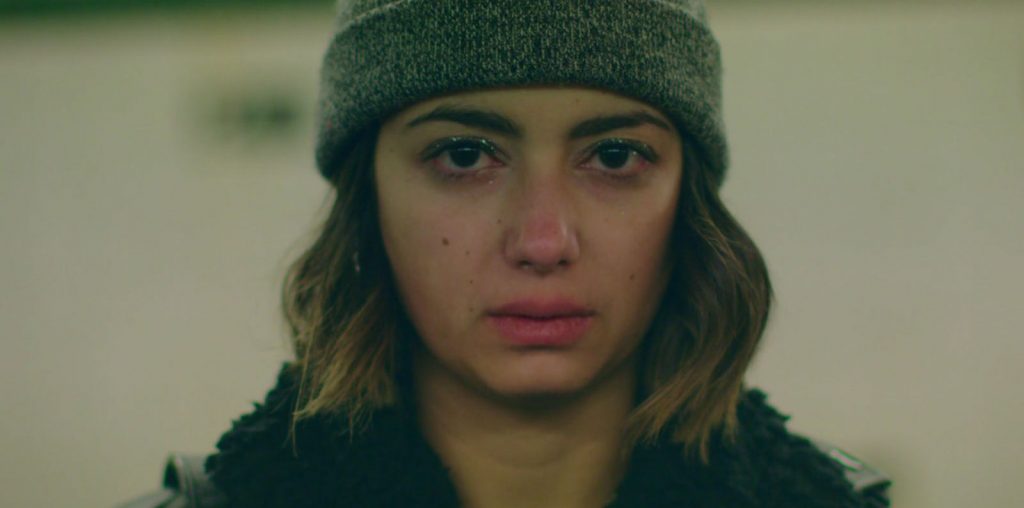
[ COCKFIGHTING HELLMAN STYLE ] ^ [ How did you get attached to “Cockfighter”? ] ^ Corman had the book and he had a script. He thought it was ready to go. When I got back from Hong Kong, he called me and asked me to do it. As per my pattern, we actually got some rewriting done before we shot the movie.
[ As this was your third film with him, what was your relationship like with star Warren Oates? ] ^ Warren was my brother. He was the closest relationship I’ve had in the process of making films. We were close in life and in our working relationship. I loved him.
[ What was the most difficult aspect of shooting “Cockfighter”? ] ^ It was such a kind of complete world that I became immersed in. It was a very fast shoot again, I think it was 23 days. It was long hours and Director of Photography Nestor Alemendros had a difficult time shooting for more than a normal workday. He suffered from problems with his eyes. He was also the camera operator. We were really limited in how long we could shoot.
[ Were those real chickens in the bathtub of the hotel room where the cockfights were held? ] ^ Those were real chickens, yeah.
[ Did the hotel where you shot the scene known about that? ] ^ (LAUGHING) uh, I don’t know if the hotel knew about that.
[ I was kind of wondering what the room might have been like for whoever stayed there after you shot the scene. ] ^ Well, you know, a bathtub is an easy thing to clean.
[ What kind of reaction was there to the film after it was done? ] ^ I don’t know if I’ve ever even seen it with an audience, other than an invited audience. I know there was a lot of outrage, just at the subject itself. Animal rights people were up in arms. As a result it never got much of a play.
[ What did author Charles Willeford, who acted in the film, think of it? ] ^ I think Charles had a good time shooting it. I never read his book, but he has a book where he talks about the experience. I think he felt it wasn’t his book, but he had the good sense to realize that a book is not a movie. There are different demands.
[ How did you get involved with “China 9, Liberty 37”? ] ^ I have been having a discussion for over a year with a producer named Elliot Kassner. We had been trading scripts for a while but never found one we both agreed on. One of the scripts he had given me was the original version of “China 9, Liberty 37”. It was called something else at the time. I hadn’t really liked it very much. About a year after this exchange had begun, I got a call from Elliot, who was in Rome. He told me he had the money to make this movie, and he asked me how quick could I get to Rome.
Everything seems to happen to me right around Christmas. I don’t why. He called me just before Christmas, and I told him I could meet him around January 8th.
As soon as a hung up, I called a friend of mine, Jerry Harvey, and said, “you’ve got to help me. I have this opportunity but it’s a terrible script. As bad a shape as my career is in now, this will end my career. Can you write a new script in three weeks?” The script that we had was almost useless, and he wrote the new script.
Kassner hated it. He was really livid but his two Italian partners loved it. So, Elliot left and left me with these two guys who turned out to be difficult. Then I made the movie.
[ How did you get involved with “The Iguana”? ] ^ I got a call from a friend of mine, who had been offered to do a movie. He was not available, but asked if I were interested. A couple of days later I got a call from the producer. I found out the reason he called me from this list that he had was that my phone number had two 7’s in it. He was into numerology and I had the right numbers, so that’s how I got hired.
[ Which of your films are you most happy with? ] ^ I’d say “Two-Lane Blacktop”, which has been enormously successful on video. It’s one of the most successful films that Anchor Bay has released. That gives me a lot of pleasure. I’m really excited about the new release of “The Shooting” and “Ride In the Whirlwind”. VCI has been terrific to work with. I think they came out fantastically well. The color’s better than it ever was on the big screen. The sound is better than it ever was. There’s so much you can do once you get into digital enhancement. It becomes the movie that you always wanted.
[ Which of your films was the most difficult to make? ] ^ There’s no contest there. Absolutely, the most difficult was “Iguana”. The most fun shoot was “China 9, Liberty 37”. Just a great experience, we had a great Italian crew who would cook pasta every night. We were all staying in a hotel and it was closed except for us. We were the only guests. It was just a joy. “Iguana” was just a nightmare. Just the most horrendous experience I’ve ever been through.
[ SUBSTITUTE DIRECTOR ] ^ In the case of the films, “Shatter”, “The Greatest”, and “Avalanche Express”, Hellman only shot part of those films, in the last two cases because the previously-assigned helmer died during production.
[ What happened with “Shatter”? ] ^ I had been in Hong Kong the year before for a picture called “In the Dream of Passion”. When that fell apart, I came back. I think they thought of me because it was a situation where they needed somebody instantly. Because of the fact I knew Hong Kong, they probably thought that I would have an advantage. This was just before “Cockfighter”.
[ How did you get involved in “The Greatest”? ] ^ That was an interesting experience, working with Muhammad Ali and getting to know him. It was a lot of fun. He wasn’t around a lot, but when he did come into the cutting room, he was just friendly, and a really nice guy.
[ How did you get involved with “Avalanche Express”? ] ^ I was drawn in by my lawyer who had become and executive at Lorimar. That was a difficult experience. It was the first time in my life that I took advantage of a tool, a weapon called “the memo”. I sent memos every day to executives at Lorimar. Everything was a fight.
[ How much of the production was completed before you were brought on board? ] ^ It was about 90% done. Principle photography, but none of the post-production or special effects. Well, special effects are a big part of the movie so maybe it was 80% done.
[ Had star Robert Shaw died by the time you arrived? ] ^ Robert Shaw had died, yes.
[ I had heard you brought in an imitator to redo all of his dialogue. ] ^ What happened was, I wrote new dialogue, and the prologue I decided to do in Russian, even though the actors had spoken English. You know, whenever you have to loop the dialogue for one of the actors in a scene, you pretty much have to loop it for all of them. It was a case where we didn’t want to have two different voices for that character. So, once we had to replace 20% or 25% of his dialogue, then we had to replace all of his dialogue.
[ TALES FROM DEVELOPMENT HELL ] ^ [ The last film you directed was “Silent Night, Deadly Night 3”. What’s happened since then? ] ^ The last two pictures I directed were in ’88 and ’89, and I worked on “Reservoir Dogs” in ’91 and ’92. I actually had a number of deals, multiple picture deals, actually, that fell through because one or another element backed out. I developed Elmore Leonard’s “Freaky Deaky” for Miramax and that got put on the shelf. That took a couple of years.
[ Did Quentin Tarantino work on that? ] ^ He was the executive producer. Now some of the other things I worked on have started to come together and not I’m in pre-production for a picture which hopefully starts shooting in January if we can get it all together quickly. I can’t say the name now because it’s up in the air.
[ Has anyone ever approached you about remaking any of your films? ] ^ Tarantino had an idea to remake “Ride In the Whirlwind”, in a different setting, but the same movie.
[ What was the big project that got away? ] ^ It was “Fat City”. I was hired to do that, and then my agent and my lawyer, God rest his soul, blew the deal. They wouldn’t let me make a deal that was half the deal I had on “Two-Lane Blacktop”. Ray Stark, who was the producer wouldn’t budge. I offered to do the movie for nothing if he would just not force me to make four other movies for half what I was getting on my “Two-Lane Blacktop” deal. I’m sorry I didn’t just do it because that’s the one that really got away.
[ What other projects do you have in the future? ] ^ Well, besides the one I’m hoping to do in January, there are two others that are finished and ready to go. One is a terrific fantasy/romance and the other is a film noir. That’s a project I’ve actually been working on for about twenty years. It’s from a classic noir novel. I can’t mention its name. It’s a terrific script and one of my favorite projects of all time.
Get the whole story in our MONTE HELLMAN SPECTACULAR! Read the feature KUBRICK IDEAS ON A CORMAN BUDGET: THE GREATNEss OF MONTE HELLMAN. Plus, read all of our Monte Hellman movie reviews: THE SHOOTING, RIDE IN THE WHIRLWIND, FLIGHT TO FURY, CHINA 9, LIBERTY 37, COCKFIGHTER, and the classic TWO-LANE BLACKTOP.
Check out FILMTHREAT.com’s INTERVIEW ARCHIVES and read hundreds of fascinating in-depth interviews with directors, filmmakers, actors and celebrities from the world of film!

